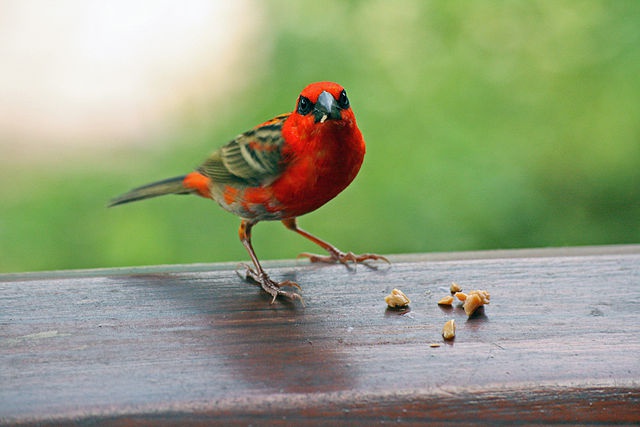Tough targets – a bird called Rasputin and the fight to protect the Seychelles atoll of Aldabra

A Madagascar fody photographed on the Seychelles' second most populated island of Praslin. The cheeky birds are now common on most Indian Ocean islands (Marion Schneider & Christoph Aistleitner / Wikicommons)
(Seychelles News Agency) - The atoll of Aldabra lies in the outermost western rim of the Seychelles archipelago of 115 islands, a wild and undisturbed spot of beauty in a world otherwise changed by human development and interference.
150,000 Aldabra giant tortoises roam freely over the sun-baked terrain of the oval-shaped ring of islands, and sharks, rays, and a wide variety of fish laze calmly in the clear waters of the shallow lagoon in the centre of the Indian Ocean atoll.
A handful of wild, unscrubbed scientists and conservation rangers also roam freely on the islands, collecting data and regularly evicting giant coconut crabs from their rudimentary accommodation.
But in the south-eastern region known as Takamaka, a war is raging between the conservationists and invaders, a war that might have been over more quickly if it had not been for the tenaciousness of a particular rebel leader, dubbed ‘Rasputin’ by rangers trying for months to dispatch him.
Rasputin is a Madagascar fody, a small bird around 12 centimetres in length. The male of the species boasts a bright red breast and head with black markings around each eye while his female counterpart is less eye-catching with olive-brown wings and tail.
Originally from Madagascar, where they are considered a pest to rice farmers, the birds are highly invasive as they are able to fly long distances and are highly intelligent and aggressive, similar to the Indian Mynah. The fodies have already invaded most of the populated islands of the Seychelles, as well as other Indian Ocean islands in the region, such as Mauritius and Réunion.
Recently, the Seychelles Islands Foundation (SIF), a public trust which manages the UNESCO World Heritage Site of Aldabra, announced in the latest edition of their monthly newsletter that their efforts to eradicate the fodies on Aldabra were almost over, with only a few birds remaining.
Among the small number of birds still eluding the rangers, Rasputin has already been shot once, but somehow managed to survive, leading the team to name him after the infamous Russian mystic Grigori Rasputin, who survived repeated assassination attempts in the early 20th century.
However, the eradication team is now employing other methods to catch the last remaining invaders, including ‘mist netting’ – the process of erecting very fine nets between the trees.
 |
| The females of the Madagascar fody species are comparatively drab next to their brightly-plumed male counterparts. (Drew Avery/Flickr) Photo license: CC-BY 2.0 |
A necessary evil
In an email interview with SNA, Dr Nancy Bunbury, the Science and Projects Programme Coordinator at SIF, said that although it was never pleasant to have to cull any species, the professional eradication team from SIF were doing the job because “they know it is the right strategy to protect Aldabra's endemic biodiversity”.
Bunbury said the most urgent reason for having to eradicate the fodies was to protect the endemic birds of Aldabra.
“Aldabra is home to an endemic Aldabra fody, which occurs nowhere else in the world,” she explained. “When a closely related species is introduced to the same area as an endemic species, the endemic species can suffer through competition, [as] introduced species tend to be better competitors, [ranging] from the introduction of new diseases, and through hybridisation, which erodes the unique genetic blueprint of an endemic species.”
Bunbury added that on other islands the Madagascar fody had been known to hybridise with endemic fodies, making the risk of Madagascar fodies cross-breeding with Aldabra fodies an occurrence which is likely to already be happening.
“There is a substantial risk of eventually losing this endemic species if no action is taken,” said Bunbury.
SIF also recently claimed the successful eradication of more than 5,000 invasive red-whiskered bulbuls on the nearby island of Assumption, thanks to a three-year eradication programme financially supported by the European Union.
Keeping Aldabra in a bubble
There are countless reasons why Aldabra is so special. Its isolation and lack of permanent inhabitants means that the atoll teems with unique and intriguing fauna and flora which can be found nowhere else in the world.
According to Dr Bunbury, one of the lesser-known facts about Aldabra is that until the population of Madagascar fodies was discovered, it was the largest tropical island in the world free from introduced bird species.
“Because introduced birds, for example, on Mahé, mynah birds, Madagascar fodies, ground doves, ring-necked parakeets and waxbills are so very common everywhere, most people no longer know what an ecosystem is like without these alien species,” said Bunbury.
“On Aldabra we have a real chance to maintain this precious status and keep the influence of alien birds out. SIF believes that we have an obligation to the world to ensure that Aldabra maintains this unique ecological integrity,” she added.
For now, SIF’s eradication team on Aldabra will be stepping up their efforts to dispatch Rasputin and his last remaining band of misfits. Over the next few weeks they will be monitoring Rasputin to identify suitable shooting positions, and will be completing the survey of Madagascar fodies in the hope that the organisation will be able to report that the atoll has once more re-gained its ‘introduced bird-free’ status.
Despite the challenge he has posed, Dr Bunbury believes it is her team who will have the last laugh.
“Rasputin is an adult male who has held the same territory for the last two years,” said Bunbury. “He has a large territory and tends to be very flighty. The team know where he is and will catch up with him - it is only a matter of time.”





